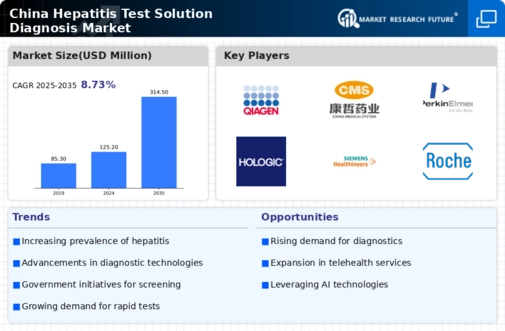Rising Healthcare Expenditure
The increase in healthcare expenditure in China is a notable driver for the hepatitis test-solution-diagnosis market. As the government and private sectors invest more in healthcare, there is a growing emphasis on preventive measures and early diagnosis of diseases, including hepatitis. The rising disposable income among the population also contributes to higher spending on health services and diagnostic tests. This trend indicates a shift towards prioritizing health and wellness, which is likely to boost the demand for hepatitis testing solutions. Consequently, the hepatitis test-solution-diagnosis market is expected to benefit from this upward trajectory in healthcare spending, leading to enhanced availability and accessibility of diagnostic services.
Government Initiatives and Funding
Government initiatives aimed at controlling hepatitis infections play a pivotal role in shaping the hepatitis test-solution-diagnosis market. The Chinese government has allocated substantial funding to enhance healthcare infrastructure and improve access to diagnostic services. For instance, the National Health Commission has launched various programs to promote hepatitis screening and vaccination. These initiatives not only raise awareness but also facilitate the development and distribution of advanced diagnostic tools. As a result, the market is likely to experience increased investment and innovation, leading to the introduction of more efficient testing solutions. The proactive stance of the government in addressing hepatitis is expected to create a conducive environment for market expansion.
Growing Demand for Point-of-Care Testing
The shift towards point-of-care testing (POCT) is emerging as a significant driver in the hepatitis test-solution-diagnosis market. POCT offers rapid results and convenience, making it an attractive option for both healthcare providers and patients. In China, the demand for such testing solutions is on the rise, particularly in rural and underserved areas where access to traditional laboratory services may be limited. The ability to conduct tests in various settings, including clinics and community health centers, enhances patient engagement and encourages more individuals to seek testing. This trend is likely to stimulate market growth as manufacturers focus on developing user-friendly and efficient POCT solutions tailored for hepatitis diagnostics.
Technological Innovations in Testing Methods
Technological advancements in testing methods are significantly influencing the hepatitis test-solution-diagnosis market. Innovations such as molecular diagnostics, rapid antigen tests, and next-generation sequencing are enhancing the accuracy and speed of hepatitis detection. In China, the integration of these technologies into routine clinical practice is expected to improve diagnostic capabilities and patient outcomes. As healthcare providers increasingly adopt these advanced testing methods, the market is likely to witness a surge in demand for innovative solutions. Furthermore, the continuous evolution of technology may lead to the development of more cost-effective testing options, making hepatitis diagnostics more accessible to a broader population.
Increasing Prevalence of Hepatitis Infections
The rising incidence of hepatitis infections in China is a critical driver for the hepatitis test-solution-diagnosis market. According to recent health reports, approximately 90 million individuals are estimated to be living with chronic hepatitis B and C in the country. This alarming statistic underscores the urgent need for effective screening and diagnostic solutions. As the government intensifies its efforts to combat these infections, the demand for innovative testing solutions is likely to surge. Enhanced awareness campaigns and public health initiatives are expected to further propel the market, as more individuals seek testing and treatment options. Consequently, the hepatitis test-solution-diagnosis market is poised for significant growth, driven by the necessity to address this public health challenge.




















Leave a Comment